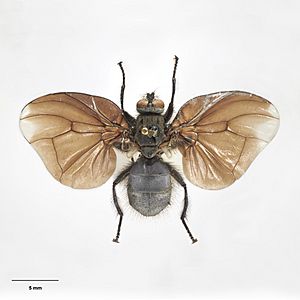Bat-winged fly facts for kids
Quick facts for kids Bat-winged fly |
|
|---|---|
 |
|
| Scientific classification |
The Exsul singularis, also known as the bat-winged fly, is a special type of fly. It is found only in New Zealand, meaning it is endemic to this country. The scientist Frederick Hutton first described this fly in 1901.
Male bat-winged flies have unusually large wings, which makes them look very different from other flies. You can find these flies mostly in high-altitude meadows near streams in the south-western South Island. They hunt soft-bodied flying insects. Scientists believe their large wings help them warm up their bodies. This is important because they live in cool mountain environments.
Contents
Discovering the Bat-Winged Fly
This unique fly was first described by Frederick Hutton in 1901. He studied a single male fly found in Milford Sound. A botanist named Arnold Wall collected this first specimen.
Hutton thought this fly was very special. He noted it was "very different in appearance from any other fly." For a while, scientists weren't sure exactly which fly family it belonged to. Eventually, it was placed in the family Muscidae, which includes common houseflies.
More than 100 years later, in 2013, the female bat-winged fly was finally described. There are two other species in the Exsul group, but neither of them have the huge wings like E. singularis.
What's in a Name?
The name Exsul was given by Hutton and means "exile" in Latin. This might refer to the remote place where the first fly was found. The second part of its scientific name, singularis, means "unique" or "singular." This highlights how different it looks from other flies.
In 1990, a scientist named Mike Meads called it the "batwinged cannibal fly." However, there is no proof that these flies eat each other. So, scientists now prefer to call them "bat-winged flies."
What Does It Look Like?
The bat-winged fly looks a lot like a plump, dark grey or black housefly. It has two dark stripes running along its back, from head to tail.
The most striking feature is the wings of the male flies. They are very wide and rounded. Female flies have wings that are a more normal size for a fly.
- Male wings: Dark brown with some clear patches. The front edge has grey spots.
- Female wings: More typical, but with brown lines along the veins.
Male flies are about 13 mm long, and their wings are 15 mm long. This gives them a total wingspan of about 25–30 mm. Females are a bit smaller, about 11 mm long with 13 mm wings. Male bat-winged flies also have very hairy legs!
Where Do They Live?
E. singularis lives in the high mountain areas of New Zealand's South Island. You can find them from the Paparoa Range in the north to northern Fiordland in the south.
The first fly was found in Milford Sound. Other flies have been seen in places like Arthur's Pass, near the Franz Josef and Fox Glaciers, and around Lake Wakatipu. They are most often seen at Mackinnon Pass.
These flies usually live at altitudes over 1000 m (about 3,300 feet). They can be found from 760 m up to at least 1800 m (about 5,900 feet). Their home is in rocky slopes and meadows near streams in the mountains.
How They Live and Hunt
Scientists have seen many bat-winged flies sunbathing on flat rocks. This happens at altitudes between 1100 m and 1370 m in Mount Aspiring National Park.
These flies hunt and eat soft-bodied flying insects. This includes moths, butterflies, and insects that emerge from water, like caddisflies. One scientist even saw a bat-winged fly eating a small caddisfly!
The large wings of the bat-winged fly help it absorb heat from the sun. This warms up its body, allowing it to fly even in the cool mountain air. We don't know much about their young (larvae) or how they breed.
Are They in Danger?
For a long time, the bat-winged fly was thought to be extremely rare. Some even called it the "world's rarest fly." Its conservation status was once listed as "Indeterminate," meaning its risk was unknown.
However, in 1996, a scientist named Patrick found that there were 65 specimens in museums around the world. About 40 percent of these were held at the Auckland War Memorial Museum.
Patrick concluded that the fly's home in hard-to-reach mountain areas made it seem rare. But in places where it lives, it's actually quite common. Its fast flight and short active period also make it hard to spot and catch.
Today, the Department of Conservation says that E. singularis is "Not Threatened." This means it is not currently at risk of extinction.

